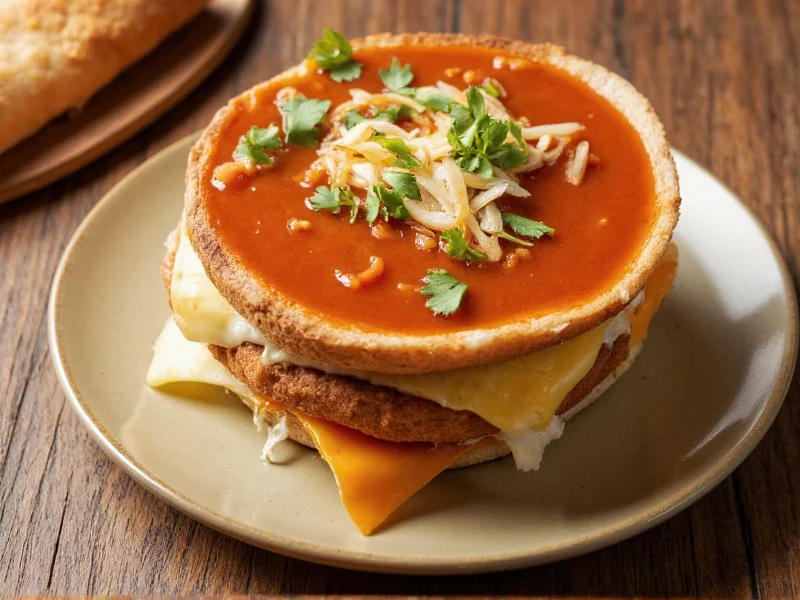There is no standard culinary concept known as a “soup sandwich.” The term typically results from confusion between “soup and sandwich” (two separate menu items commonly served together) or mishearing “soup sambo,” an outdated term for a specific sandwich. What people often mean is pairing soup with a sandwich, a classic combination in American diners and cafes since the early 20th century.
Understanding the Soup and Sandwich Confusion
When people search for “soup sandwich,” they’re usually looking for information about the beloved culinary pairing of soup served alongside sandwiches. This common menu combination has been a staple in American dining since the 1920s, when diners began offering affordable lunch specials featuring both items. The confusion likely stems from how restaurants advertise these pairings—“soup and sandwich” can sound like “soup sandwich” when spoken quickly.
The History of Soup and Sandwich Pairings
The tradition of serving soup with sandwiches emerged during Prohibition when restaurants needed affordable lunch options. By the 1930s, diners nationwide featured “soup and sandwich” specials as economical meals. The most famous pairing—grilled cheese with tomato soup—became iconic during World War II when cheese and canned soup were rationed but still accessible.
Popular Soup and Sandwich Combinations
Certain pairings have stood the test of time due to complementary flavors and textures. Here are the most enduring combinations:
| Soup Type | Ideal Sandwich Pairing | Why They Work Together |
|---|---|---|
| Tomato soup | Grilled cheese | Creamy texture contrasts with crispy bread; acidity balances richness |
| Chicken noodle | Turkey club | Herb flavors complement; broth enhances poultry notes |
| Clam chowder | Oyster roll | Regional pairing; similar seafood profiles enhance each other |
| French onion | Melted provolone on sourdough | Caramelized onions create flavor harmony; cheese adds richness |
Why Soup and Sandwich Pairings Work So Well
The success of soup and sandwich combinations isn’t accidental. Food scientists note several reasons for their perfect pairing:
- Temperature contrast – Hot soup with room-temperature or toasted sandwiches creates sensory variety
- Texture interplay – Creamy soups balance crunchy bread; chunky soups pair well with soft sandwiches
- Flavor layering – Each bite of sandwich followed by soup sip creates evolving taste experiences
- Nutritional balance – Carbohydrates from bread complement protein and vegetables in soup
Regional Variations Across America
Different regions have developed signature soup and sandwich pairings based on local ingredients and cultural influences:
- New England – Clam chowder with lobster roll (despite the “roll” misnomer, it’s technically a sandwich)
- Midwest – Beer cheese soup with bratwurst sandwich
- South – Gumbo with po’ boy sandwich
- West Coast – Artichoke soup with avocado toast sandwich
Creating Perfect Pairings at Home
When crafting your own soup and sandwich combinations, consider these professional chef tips for ideal pairings:
- Match intensity levels – Light broths with delicate sandwiches, hearty stews with robust sandwiches
- Consider acidity balance – Acidic soups (like tomato) need rich, fatty sandwich components
- Complement dominant flavors – If soup features herbs, incorporate similar herbs in the sandwich
- Vary textures deliberately – Creamy soup + crunchy sandwich creates satisfying contrast
- Season both components thoughtfully – Underseason soup slightly since sandwiches often contain salty elements
Common Misunderstandings About Soup Sandwiches
Several misconceptions persist about “soup sandwiches.” Let’s clarify:
- “Soup sambo” confusion – This was a 1950s-60s term for a specific sandwich, not a soup-filled sandwich
- Dipping misconception – While some sandwiches are dipped in soup (like French dip), this differs from standard pairings
- Menu terminology – Restaurants list “soup and sandwich” as separate items, not a single dish
- Cultural references – Some TV shows or movies might use “soup sandwich” colloquially, causing confusion
Modern Twists on Classic Pairings
Contemporary chefs have elevated traditional soup and sandwich combinations with creative approaches:
- Deconstructed pairings – Serving sandwich components alongside soup for interactive dining
- Ingredient swapping – Using soup ingredients within the sandwich (e.g., tomato soup elements in grilled cheese)
- Global fusion – Miso soup with banh mi, or ramen broth with Vietnamese pork sandwich
- Seasonal variations – Butternut squash soup with apple-brie sandwich in fall
Perfecting Your Soup and Sandwich Experience
For the optimal dining experience when enjoying soup with sandwiches, follow these practical tips:
- Serve temperatures matter – Soup should be piping hot (165°F/74°C) while sandwiches should be warm but not scalding
- Portion balance – Standard lunch portions are 8-12 oz soup with 4-6 oz sandwich
- Order of operations – Start with soup to open the palate, then alternate between items
- Accompaniments enhance – A simple green salad completes the meal without overwhelming











 浙公网安备
33010002000092号
浙公网安备
33010002000092号 浙B2-20120091-4
浙B2-20120091-4